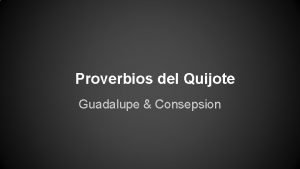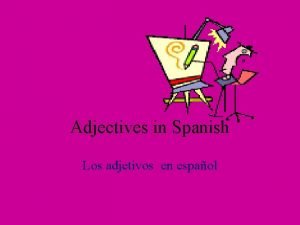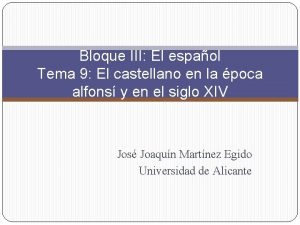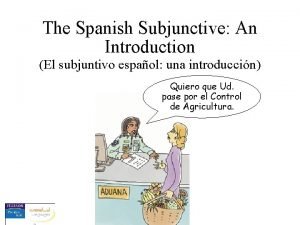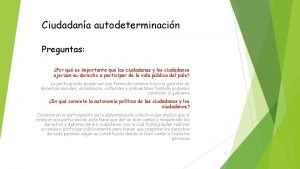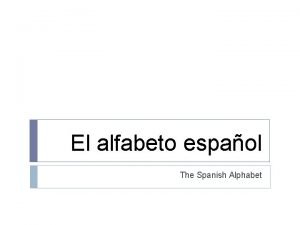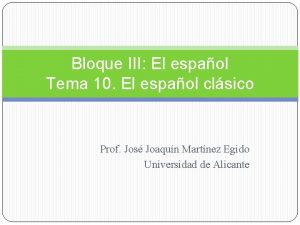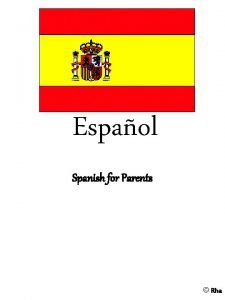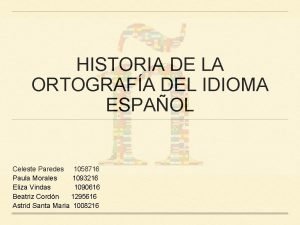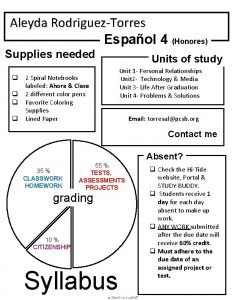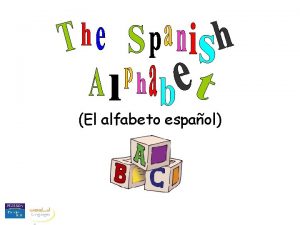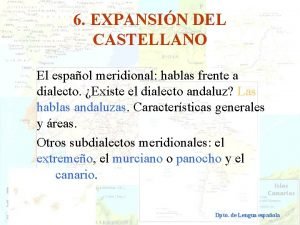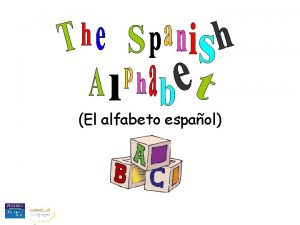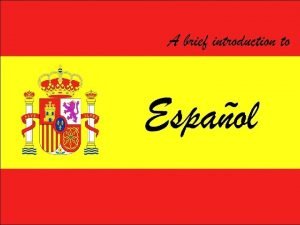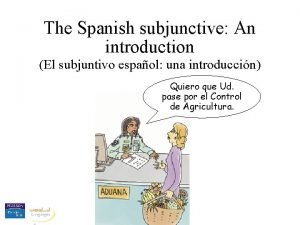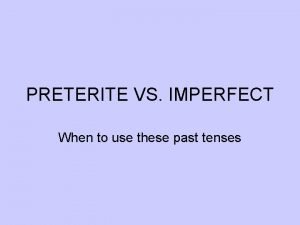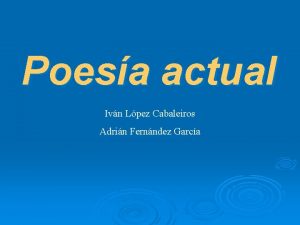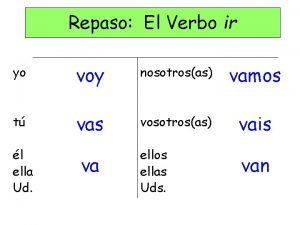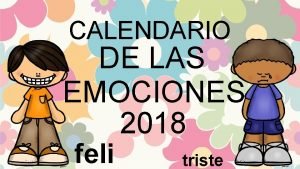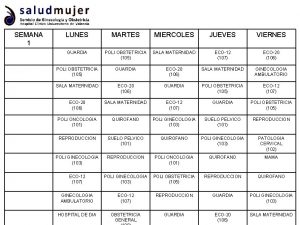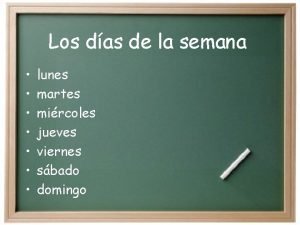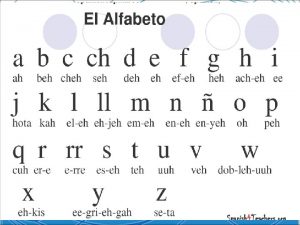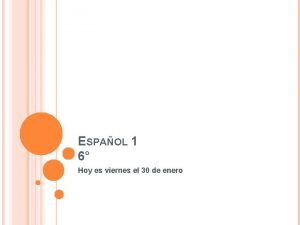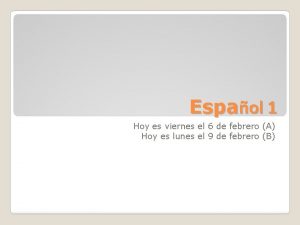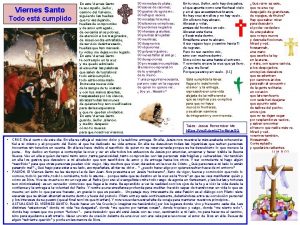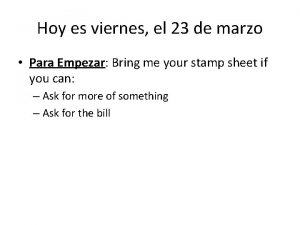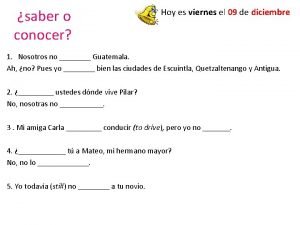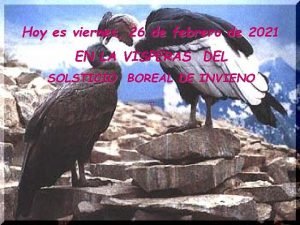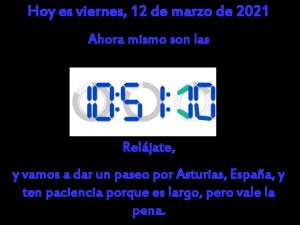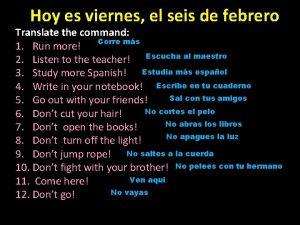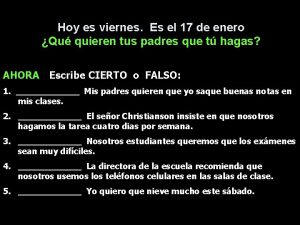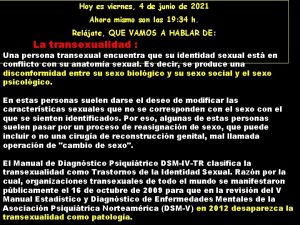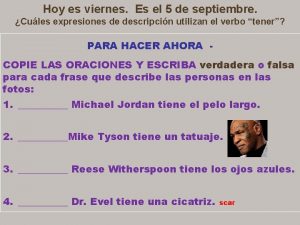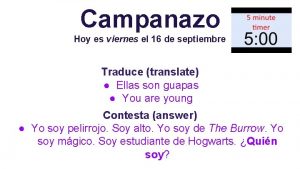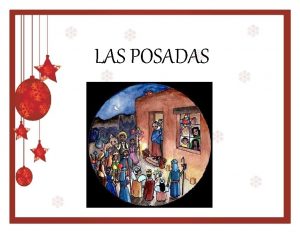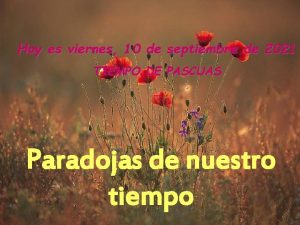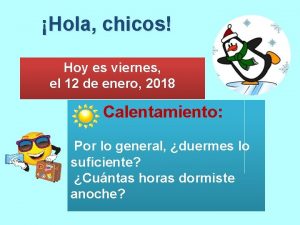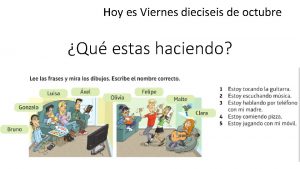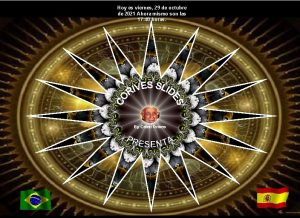ESPAOL II Hoy es viernes el 9 de



































- Slides: 35

ESPAÑOL II Hoy es viernes el 9 de mayo Es lunes el 12 de mayo O

El horario Hazlo Ahora Vocabulario Repasamos Capítulo 3 B 3 A/3 B packet: Make sure you have completed 3 A-4, 5, 6, 7, 8 Make Up Chapter 3 A test (Geometry SOL Day, Fri. ) Aprendemos repasamos Reading Comprehension Actividad 3 A-4 Direct Object Pronouns Actividad 3 A-5 Preterite of SER & IR, ESTAR, PODER, HACER, TENER Actividad 3 A-6 & 7 Crossword Puzzle Actividad 8

Cada día: � Habla español 8 minutos cada día � Aprende el vocabulario nuevo write each word and definition 5 -10 times each or make flashcards, quizlet. com is a good resource y, repasa las otras palabras. Tienes que saber como se escribe, que quiere decir la palabra y también, la pronunciación. Chapter 3 B Packet ejercicio 3 B-1: ¿Cómo se llega? Aprende el vocabulario Habla español Bring your materials for Chapter 3 A/3 B Mklspanish@hotmail. com Quizlet. com: maklineliber Puede ayudarte

LOS QUE NO HAN TEMINADO COSAS Hora 05 - 1 Prueba Vocabulario 3 A Hacer, Tener, Poder, Estar en el pretérito Lane 5 6 Fecha 05 -05 05 -06

Trabajo de clase mientras ciertos estudiantes toman el Examen 3 A Completa estos ejercicios en tu paquete 3 A: 4, 5, 6, 7, 8

3 A-4 1. El jabón perfecto ¿Qué es el producto del anuncio? ¿Para qué puedes usarlo? El producto del anuncio es Limba. Puedes usarlo para …. Lavarse el cuerpo? (respuesta personal sobre los usos del jabón) 2. Según ese anuncio, ¿qué jabón es mejor que Limba? La marca Limba es mejor de todas. 3. ¿Qué tiene que hacer para conocer la diferencia de Limba? Sólo hay que probarlo y va a saber que no hay jabón mejor que Limba. 4. ¿A los médicos les gusta Limba? Absolutamente, les gusta los médicos Limba. 5. ¿Qué producto se vende con el nombre Limba? ¿Dónde puedes comprar este producto? También hay un champú, que se vende con el nombre Limba. Puedo encontrarlo en una farmacia.

3 A-5 Tengo que hacerlo 1. ---¿Tienes la pasta dental? ---No hay. No ____ la compré. 2. ---¿Vas a enviar la carta? ---Sí, ____ eché al buzón hace una hora. la 3. ---¿Tienes que devolver los libros? ---No, _____ saqué ayer. los 4. ---¿Necesitas compararte una raqueta de tenis? la ---No, ya _______ tengo. 5. ---¿Necesito más chapú. ---Puedo compara _______ en el supermercado. lo

3 A-5 Tengo que hacerlo 6. ---¿A qué hora se cierra el banco? lo ---Se cierra a las cinco. _____ puedes cobrar ahora. 7. ---¿Hay gasolina en el tanque? lo ---Sí, ____ llenamos hoy por la mañana. 8. ---¿Tienes sellos? ---Sí, _____compré hoy por la mañana. los

3 A-6 Un día. . . fui 1. Yo _____ al banco. fue 2. Ud. ____ a la farmacia. fuimos 3. Mis amigos y yo ______ al supermercado. 4. ¿Tú ______ al correo? fuiste 5. Ramón y Manolo _______ a la estación de servicio. fueron 6. Mis padres ______ a casa. fue 7. Javier ______ a la tienda de equipo deportivo.

3 A-6 Un día. . . 1. Los libros fueron interesantes. 2. El partido de fútbol americano fue difícil. 3. La obra de teatro fue emocionante.

3 A-7. Conversaciones Amigos: Ayer fuimos a la tienda de equipo deportivo. Nosotros _________ en la tienda por una estuvimos hora. Rosa: ¿________ encontrar las camisetas? Pudieron Amigos: No, allí no. _______ que ir a otra tienda. tuvimos Allí las ______ pudimos comprar.

3 A-7. Tomás: Clara: Conversaciones ¿Cuántas horas pasaste en la biblioteca ayer? ________ allí cuatro horas por la tarde. Estuve Tomás: ¿________ terminar tu informe? Pudiste Clara: No, no lo _______ terminar. pude Tomás: ¿Qué ______ entonces? hiciste Clara: ______ que volver por la noche. Tuve Tomás: ¿Fuiste sola? Clara: Sí. Nadie _____ ir conmigo. pude


CAPÍTULO 3 B ¿Cómo se va?

MANOS A LA OBRA PÁGINA 138 -139 Gramática: Direct Object Pronouns A direct object tells who or what receives the action of the verb. yo Devolví el libro. I returned the book. What is the verb? What is the subject? Who or what did I verb? ID: direct object noun

MANOS A LA OBRA PÁGINA 138 -139 Gramática: Direct Object Pronouns To avoid repeating a direct object noun, you can replace it with a direct object pronoun. me nos te os lo, la los, las to him/you/her to them yo lo Devolví el libro. I returned the book. What is the verb? What is the subject? Who or what did I verb? ID: direct object & write pronoun over the noun

MANOS A LA OBRA PÁGINA 138 -139 Gramática: Direct Object Pronouns To avoid repeating a direct object noun, you can replace it with a direct object pronoun. me nos te os lo, la los, las to him/you/her to them yo lo Devolví el libro. I returned the book. Rewrite the sentence, putting the DOP in front of the conjugated verb. Lo devolví. I retured it.

MANOS A LA OBRA PÁGINA 138 -139 Gramática: Direct Object Pronouns Direct Objext Pronouns have the same gender (masculine or feminine) and number (singular or plural) as the nouns they replace. me nos te os lo, la los, las to him/you/her to them ¿Devolviste los libros a la biblioteca? Did you return the book to the library? ¿Ayudaste. a tu mamá en casa? Sí, la ayudé.

MANOS A LA OBRA PÁGINA 138 -139 Gramática: Direct Object Pronouns When an infinitive follows a verb, the Direct Object Pronoun can be placed before the conjugated verb or after and attached to the infinitive. ¿Sacaste el libro sobre Simón Bolivar? No, no lo pude sacar. O No, no pude sacarlo. Gramactiva

MANOS A LA OBRA Actividad 12: ¡A lavar! PÁGINA 138 Cuando Teresa regresa a casa por la tarde, tiene esta conversación con su madre. Léela, y escribe el pronombre apropiado: lo, la, los o las. Mamá: Teresa: Mamá: ¿Qué tal la película, Teresa? la Bien, mamá. Me gustó mucho. Tú _____ viste anoche, ¿no! Sí, pero no me gustó. Oye, ¿Dónde están las cosas que compraste en la farmacia? No ______ veo. El champú está sobre la mesa. ¿No ______ ves? Ah, sí, aquí está sobre la mesa. ¿Y la pasta dental?

MANOS A LA OBRA Actividad 12: ¡A lavar! PÁGINA 138 Cuando Teresa regresa a casa por la tarde, tiene esta conversación con su madre. Léela, y escribe el pronombre apropiado: lo, la, los o las. Teresa: Mamá: Teresa: la dejé en el baño. Creo que _____ Muy bien. ¿Y enviaste las cartas? Sí, mamá. _______ Las envié después de ir a la farmacia. Gracias, hija. Ah, ¿compraste un regalo para tu abuela? ¡Sí, mamá! Le compré un collar muy bonito. ¿_____ quieres ver? Lo

MANOS A LA OBRA Actividad 12: ¡A lavar! PÁGINA 138 Cuando Teresa regresa a casa por la tarde, tiene esta conversación con su madre. Léela, y escribe el pronombre apropiado: lo, la, los o las. Mamá: Teresa: Mamá: ¿Qué tal la película, Teresa? la Bien, mamá. Me gustó mucho. Tú _____ viste anoche, ¿no! Sí, pero no me gustó. Oye, ¿Dónde están las cosas que compraste en la farmacia? No ______ veo. El champú está sobre la mesa. ¿No ______ ves? Ah, sí, aquí está sobre la mesa. ¿Y la pasta dental?

MANOS A LA OBRA Actividad 12: ¡A lavar! PÁGINA 138 Cuando Teresa regresa a casa por la tarde, tiene esta conversación con su madre. Léela, y escribe el pronombre apropiado: lo, la, los o las. Mamá: Teresa: Mamá: Sí, pero más tarde. Ahora tenemos que limpiar la cocina. Tú puedes lavar los platos. ¡Ay! No puedo lavar _____, los mamá. . . ¡Se me olvidó comprar el detergente! No importa, Teresa. ¡Yo _______ compré ayer! Y ahora, ¡A lavar!

Repasamos la gramática:

Libro de Trabajo: Actividad 3 A 5

REPASO DE GRAMÁTICA

Subject Pronouns Los pronombres de sujeto página 82 yo I nosotros nosotras we anybody y yo tú you, familiar or friendly vosotros vosotras you all anybody y tú Ud. él, ella you –formal he, she Uds. ellos ellas you all they The process: 1. ASK if the subject is singular or plural (eliminate ½ of your choices) 2. ASK is there a YO in the subject. . . If yes stop questions there if not 3. ASK if there is a tú in the subject 4. If NO to 2 and 3, your subject is THIRD PERSON.

página 60 Definite and Indefinite Articles 1 B Definite and indefinite articles El and la are called definite articles and are the equivalent of “the” in English. El is used with masculine nouns; la is used with feminine nouns. You’ve already seen words with definite articles: el libro la carpeta the book the folder Un and una are called indefinite articles and are the equivalent of “a” and “an” in English. Un is used with masculine nouns; una is used with feminine nouns: un libro una carpeta a book a folder Strategy Learning by Repetition When you learn a new noun, say it aloud, along with its definite article, as often as you get a chance. Eventually, you will find that words just “sound right” with the correct definite article and you will know whether nouns are masculine or feminine.

página 60 Definite and Indefinite Articles 1 B Definite articles el la the Indefinite articles un una a a Strategy Learning by Repetition When you learn a new noun, say it aloud, along with its definite article, as often as you get a chance. Eventually, you will find that words just “sound right” with the correct definite article and you will know whether nouns are masculine or feminine. Need more help with articles? Watch the Gram. Activa video.

página 60 Definite and Indefinite Articles 1 B Definite articles el la the los las the Indefinite articles un a(an) una a(an) unos unas some

1 B Word order: Placement of Adjectives In Spanish, adjectives usually come after the noun they describe. Notice how artística follows chica in the Spanish sentence. Margarita es una chica artistica. Margarita is an artistic girl. Did you notice that in the English sentence the adjective comes before the noun? página 62 ¿Recuerdas? To make a sentence negative you place the word no before the verb. • Eduardo no es un chico serio. • No me gusta jugar videojuegos.

1 B Word order: Placement of Adjectives página 62 Here’s a simple pattern you can follow when writing a sentence in Spanish.

Repasamos los verbos un poco más. . . patinar - to skate patino patinamos patina dibujar – to draw dibujo dibujamos patináis dibujas dibujáis patinan dibujan practicar - to practice usar– to use practico practicamos uso usamos practicas practicáis usas usáis practican usan esquiar - to ski montar– to ride esquío practicamos monto montamos esquías esquíáis montas montáis esquían montan

SER O ESTAR When you have a sentence that needs the verb to be…. How do you decide? SER estar Describes what a person is really like How you´re feeling Tells time and where you are Tells the date Always use the verb Tells occupation, profession ESTAR Tells where some one is from Tells origin or nationality Describes a person´s condition, location, position or how someone feels.

To add Spanish language (characters to your keyboard) SELECT EACH: START -- Control Panel --- REGION AND LANGUAGE SELECT: KEYBOARDS AND LANGUAGES, THEN CHANGE KEYBOARDS SELECT: ADD, THEN FIND SPANISH (SPAIN, TRADITIONAL SORT) SELECT KEYBOARD UNDER SPAIN, TRADITIONAL SORT AND CLICK ON SPANISH. AT THE BOTTOM RIBBON OF YOUR COMPUTER, YOU WILL SEE EN --- THAT IS FOR ENGLISH. IF YOU CLICK ON ES BELOW IT, YOU WILL BE IN THE SPANISH KEYBOARD. Make sure when you log into a program ES is showing on the ribbon. To type accent marks, use the apostrophe key next to the ENTER key. Depress the apostrophe and then the letter you want to have accented. To type a ñ you press the colon key which is to the left of the apostrophe. ¿ is made by typing the shift key and the plus sign ? Is made by typing the shift key and the minus sign ¡ is made by typing the plus sign
 Alegrate pueblo de dios
Alegrate pueblo de dios Lectio divina de hoy viernes
Lectio divina de hoy viernes Lectio divina de hoy viernes
Lectio divina de hoy viernes Maldicientes significado
Maldicientes significado Positive adjectives in spanish
Positive adjectives in spanish Preparatic
Preparatic En espaol
En espaol El espaol
El espaol Escapaa
Escapaa Examen de ciudadana 2020 en espaol
Examen de ciudadana 2020 en espaol Penas graves
Penas graves Preguntas para la ciudadana en espaol
Preguntas para la ciudadana en espaol Spanish alphabet letters
Spanish alphabet letters El espaol
El espaol Espaol
Espaol Trabajos en espaol birmingham
Trabajos en espaol birmingham Idioma espaol
Idioma espaol Citizenship test en espaol
Citizenship test en espaol Abecedario espaol
Abecedario espaol Español meridional
Español meridional Vowel + y
Vowel + y 10 preguntas de miguel hidalgo con respuesta
10 preguntas de miguel hidalgo con respuesta Que son consonantes
Que son consonantes Vamos a aprender español
Vamos a aprender español Espaol
Espaol Preguntas de ciudadania en espaol
Preguntas de ciudadania en espaol Conocer in preterite vs imperfect
Conocer in preterite vs imperfect Viernes santo ciclo c
Viernes santo ciclo c Viernes poema
Viernes poema Vamos verbo
Vamos verbo Feli triste
Feli triste Misterio de los viernes
Misterio de los viernes Viernes 13
Viernes 13 Semana 1 lunes martes miércoles jueves viernes
Semana 1 lunes martes miércoles jueves viernes Mircoles
Mircoles Lecturas del jueves santo ciclo b
Lecturas del jueves santo ciclo b



